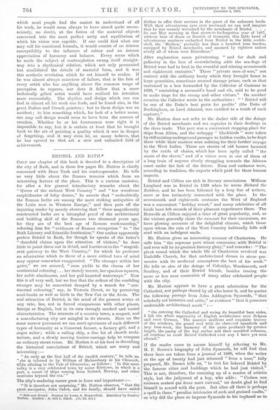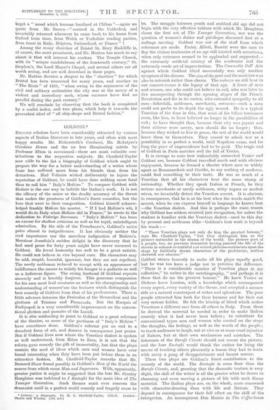BRISTOL AN]) BATH.* ONLY one chapter of this book is
devoted to a description of the city of Bath, and in these few pages Mr. Hutton is chiefly concerned with Beau Nash and his contemporaries. He tells us very little about the Roman remains which form an interesting feature of the place. This is a curious omission, for after a few general introductory remarks about the " Queen of the radiant West Country " and " her wondrous amphitheatre of lofty downs," he asserts that " undoubtedly the Roman baths are among the most striking antiquities of the Latin race in Western Europe," and then puts off the inquiring reader by merely observing that " these magnificently constructed baths are a triumphal proof of the architectural and building skill of the Romans two thousand years ago, for they are of the best ago of Roman workmanship," referring him for " evidences of Roman occupation " to " the Bath Literary and Scientific Institution." Our author apparently prefers Bristol to Bath, for though he speaks of the latter's " threefold claims upon the attention of visitors," he does little to point these out in detail, and hurries on to the " magnifi- cent gateway to the West Country," for which he professes an admiration which to those of a more critical turn of mind may appear somewhat exaggerated. " The stranger within her gates," we are assured, " soon yields to the charm of her continental colouring ... her stately towers, her spacious squares, her noble almshouses, and her gull-haunted waterways." Now this is all very well, but we fear that the ardour of the confiding stranger may be somewhat damped by a search for " con- tinental colouring," say, in Victoria Street, or by perceiving mud-banks as well as birds in the New Cut or the Avon. The real attraction of Bristol, in the mind of the present writer at any rate, lies, not in forced comparisons with other places, foreign or English, but in its own strongly marked and varied charaeteristies. The interests of a country town, a seaport, and a manufacturing city are mingled in its streets. Here on the same narrow pavement we can meet specimens of such different types of humanity as a Somerset farmer, a factory girl, and a negro sailor ; while a sailing ship, a fine bit of church archi- tecture, and a slowly moving timber-carriage help to compose an ordinary street scene. Mr. Hutton is at his best in describing the historical associations of Bristol, which are many and interesting :- " As early as the first half of the twelfth century," ho tells us, " she is rarerred to by William of Mahnesbury in his Chronick,
when alluding to the Vale of Gloucester, as follows : this same valley is a very celebrated town by name Bristowe, in which is a port, a resort of ships coming from Ireland, Norway, and other countries beyond the sea.' "
The city's seafaring career grew in fame and importance :- " It is therefore not surprising," Mr. Hutton observes, " that the great navigator, John Cabot, and his family, should have sailed
* Rath and Bristol, Painted by Laura A, Happerlield. Described by Etas.] ey Button, Leaden ; A. and C. Black, 17s, ed. ueq thither to offer their services in the quest of the unknown lands. With their adventurous eyes ever westward we can well imagine that ho was warmly welcomed by the merchants of Bristol. . . . So one May morning in that never-to-be-forgotten year of 1497, without beat of drum or flourish of trumpets, this little band of adventurous mariners embarked from Bristol in the little cockle- shell, the ' Mathew,' probably less than a hundred tons burden, equipped by Bristol merchants, and manned by eighteen sailors nearly all of whom were Bristolians."
After exploration came privateering, " and for dash and gallantry in the face of overwhelming odds the sea-dogs of Bristol were bad to beat in the eventful and stirring seventeenth and eighteenth centuries." These " private men-of-war," not content with the ordinary booty which they brought home in large quantities, sometimes secured strange prizes, such as that contained in a box forwarded by the Collector of Customs in 1630, " containing a mermaid's hand and rib, said to be good to make rings for the cramp and other virtues." On another occasion the Collector wrote to the authorities " Bristol will be one of the Duke's best ports for profits' (the Duke of Buckingham, as Lord Admiral, was entitled to a tenth of each capture)."
Mr. Hutton does not refer to the darker side of the doings of the Bristol merchants and sea captains in their dealings in the slave trade. This port was a convenient stopping-place for
ships from Africa, and the unhappy " blackbirds " were taken by still existing underground passages to hidden vaults, to be kept there while their masters were refitting for their farther voyage to the West Indies. There are stories of old houses haunted
by the rattle of chains, which has been aptly called ." the music of the slaver," and of a vision seen in ono of them of a long train of negroes slowly struggling towards the African coast under the lash of the driver. Rum and cutlasses were, according to tradition, the exports which paid for these human. imports.
Bristol and Clifton are rich in literary associations. William • Langland was in Bristol in 1399 when he wrote Richard the Redeless, and he has been followed by a long line of writers,. more or less intimately connected with the place. In the seventeenth and eighteenth centuries the West of England Was a convenient " holiday resort," and many celebrities of all • kinds have left records of their pleasant experiences there. The Hotwells at Clifton enjoyed a time of great popularity, and, as
the visitors generally chose the summer for their excursions, we have glowing accounts of the delightful climate, which those upon whom the rain of the West Country habitually falls will read with an indulgent smile.
Mr. Hutton gives an interesting account of Chatterton. • He calls him " the supreme poet whose connexion with Bristol is ' and ever will be itagreatest literary glory," and remarks : • " The pivot round which the whole life of Chatterton revolved was Radcliffe Church, for that architectural dream in stone epee. meates with its medieval atmosphere the best of his work." He tells us also of the doings of Coleridge, Wordsworth,. and Southey, and of their Bristol friends, besides tracing . the more or less near connexion of many other celebrated people with the city.
Mr. Hutton appears to have a great adthiration for the Cathedral, tot perhaps shared by all who know it, and he quotes the following passage from John Addington Symonds, that scholarly art historian and critic," as evidence " that it possesses' undeniable architectural merit " :- " On entering the Cathedral and seeing its beautiful bare aisles, I felt the whole superiority of English architecture over Belgian and oven German. The massive mullions and exquisite tracery of the windows, the grand roof with its clustered spandrels and lacy boss-work, the harmony of the parts produced :by greater • length, the purity of the bay arches and their moulded columns, , all combine to exalt Bristol Cathedral over any I have yet seen abroad."
If the reader cares to amuse himself by referring . to Mr. H. F. Brown's biography of John Symonds, he will And that these lines are taken from a journal of 1860, when the writer at the age of twenty had just returned " from a tour," fully prepared, Mr. Brown tells us, " to test his beloved Bristol by the famous cities and buildings which he had just visited." This is not, therefore, the summing up of a master of artistic style, but the judgment of a boy, who adds : ",Coelum non , anintunt mutant qui trans mare currant," no doubt, glad to find himself in accord with the poet. But after all there is perhaps a spell in these " peculiar intricacies of arch and grained vaults," or why did the place so impress Symonds in his boyhood•as,to
beget a mood which became localized at Clifton "—again we quote from Mx. Brown—" centred in the Cathedral, and invariably returned whenever he came back to his home from Oxford term time, from Welsh or Yorkshire reading parties, from tours. in Italy, Belgium, Switzerland, or France " ?
Among the many churches of Bristol St. Mary Radcliffe is of course, the most promiuent, and Mr. Hutton has much to say about it that will interest his readers. The Temple Church, with its " unique candelabrum of the fourteenth century," St. Stephen's, the Lord Mayor's Chapel, and several others are all worth seeing, and are well described in these pages.
Mr. Hutton devotes a chapter to the charities " for which Bristol has been renowned for many years, and another to " The Riots " of 1831, " when owing to the supineness of the civil and military authorities the city was at the mercy of a violent. and incendiary mob, whose excesses have had no parallel during the past century."
We will conclude by observing that the book is completed by a useful index, and two plans, which help it towards the proverbial ideal of " all ship-shape and Bristol fashion,"





















































 Previous page
Previous page